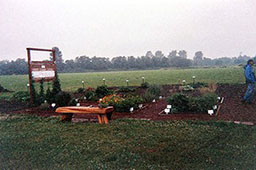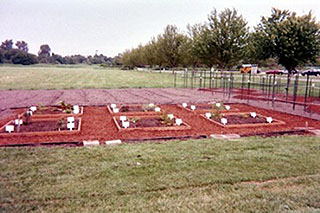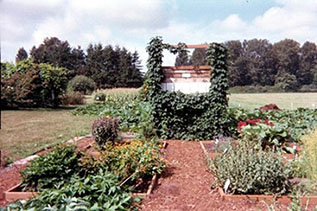Make the most of culinary herbs and spices.
Other articles you might enjoy:
1. The Simple, Essential Herb Garden
3. The Pleasure of Fresh Herbs
4. Combination Plantings Equal Culinary Pots
An Herb Garden Takes Root
by Sandra Bowens
Here's one that's full of our favorite recipes because we wrote the book! It is also full of information, helpful hints and ideas for using herbs and spices in your kitchen.

With some projects you get an idea, have to sell it to the powers that be and then work hard to get it off the ground. Other projects just seem to fall into your lap. The latter is how I became involved in the Herbs in History demonstration garden.
I had just been graduated from our local Master Gardener training program when two veteran gardeners approached me with the idea of establishing a medicinal herb garden. They wanted a permanent installation in an area where they had been planting a different display every year.
Our site would be the Hovander Homestead Master Gardener's Demonstration Garden. This is a large area that surrounds an historical home that is open to the public.
Concept and design
As a practical matter, the theme of the garden evolved from strictly medicinal plants to a collection of useful plants. We concentrated on those herbs that had historical significance in both the kitchen and natural medicine. Since Master Gardeners are affiliated with Western Washington University we wanted to be especially careful of not appearing to be dispensing medical advice.
While many of the old uses for herbs may still be viable, science has proven that some plants are actually dangerous. Alternative healing methods should be undertaken only with supervision of a doctor or trained herbalist. That said, it is still interesting to know how assorted plants have been used in the past.
We had other criteria as we selected specimens. Rather than have to sow seeds year after year, we wanted to have perennials. We didn't want to duplicate plants that were already growing in an existing herb garden within the homestead's landscaping. Some herbs have made our local noxious weed list so we had to be mindful of that. And we wanted beauty.
The garden plot itself would be divided into six planting beds that would hold four herb plants each. We delineated the beds with wooden frames. Outside the planting beds we would create paths and define the area with wood chips. Installing all of this "hardware" became the first step in the process. With so many able hands available in the form of other Master Gardeners, the work went fast.
Planting
Throughout the late winter and early spring we collected the plants. Donations came in from fellow Master Gardeners, friends and local nurseries. We had to buy a few of the more unusual specimens like the green tea plant and the North American scullcap. The flax, mustard and coriander would be started from seed, exceptions to our 'no annuals' rule.
Our intention was to establish a beautiful space for the public to enjoy as they learned about specific plants. A seating area would be welcome so we commissioned a local wood artist to create a bench. The result was perfect beyond any of our expectations. Rustic in appearance, with the seat fashioned from a slab of wood and positioned atop two stumps, our bench fit the setting more than any other style we had considered.
Each plant would need to be labeled, we knew. After much searching and debate we decided on plastic stakes that could be inserted into the ground next to each plant. The common name, botanical name and a tidbit of information about the history of the specimen would be printed and affixed to the stake. Another large wooden sign would announce the name of the garden and give a brief history of herbs.
Upkeep
Once the plants were in and a last layer of wood much was laid, upkeep became the focus. New plantings need more regular watering than those that are established. Weeds thrive on freshly turned soil and those regular waterings.
Sometimes plants just don't make it. This was the case with the marsh mallow. It grew and flowered but soon died off.
Tradition dictates that peacocks roam the Hovander property. Turns out peacocks have a real affinity for horseradish. They also enjoy mustard and like an occasional peck at rhubarb, we learned. Sometimes we would find shallow craters in the planting beds where a peacock had chosen to roost for a bit. One of our members knew that arranging short, sharp pieces of bamboo to stick up from the ground discouraged this activity.
Closed for winter
By the end of the season we knew that our efforts to create a beautiful and educational public space had been realized. Feedback from other Master Gardeners as well as the public gave us that reassurance. The park ranger reported that every time he looked at the bench, someone was sitting on it.
The demonstration plots wrap up each year in the beginning of November. The very real threat of flooding from the nearby river requires anything that might float to be removed for the year. For the Herbs in History garden we needed to store the bench and the signs.
Some plants, like the hops and calendula, would die back during the winter so we went ahead and pruned them. We harvested tarragon and coriander seeds. We dug a trench around the Monarda plant, removing errant roots to keep it from spreading out too much. Just to be sure it would survive, we transplanted the green tea into a pot for safe storage in a garage.
Final thoughts
Come spring we will see how our new plants fared over the winter. We will replace our signs and reposition the bench and start over again. The best part of gardening is that each season is like a reunion. Old friends return with vigor bringing new beauty to what has been a cold, dark world.

This photo shows the garden just after planting in the spring. A demonstration dahlia bed is laid out on the right and the patch of soil behind the garden will be the pumpkin patch.

By the end of the season the plants have filled in. Notice how well the hops have grown; from two little plants, the vines nearly engulf the sign. Beyond the sign you can see the pumpkin patch is thiving, too.
The Plants
The following is a list of the plants we placed in the Herbs in History Garden.
Arctic Blue Willow (Salix purpurea 'Nana' ) Although some willows will grow to 30 feet or more, this cultivar stays at a tidy five feet and likes fairly wet conditions. Willows have long been used medicinally as an analgesic and to treat arthritic problems. The bark is used most often for the active constituent phenolic glycoside but the leaves of some varieties are also known to contain this precursor to aspirin. While willow bark is considered safe for use as a pain reliever it also a blood thinner and should be used with caution or, for some individuals, not at all.
Anise hyssop (Agastache foeniculum) The common name of this perennial is confusing as it is neither anise nor hyssop. Legend has it the plant became popular after a seed salesman in the Korean War brought some seeds home. He called it Korean mint. In fact, anise hyssop is native to Korea and the United States, where it grows wild in Texas and the plains states. Bees love this plant. Very little is written about the medicinal properties of anise hyssop but it has many applications for the dessert chef. The cut flower spikes make a fun "stir stick" garnish for iced tea.
Green tea (Camellia sinensis) Known in China for 5000 years, this evergreen shrub has a long taproot and produces pale yellow flowers with 7-8 petals in the fall. The young buds and leaves are preferred in commercial tea harvest. All types of tea, green, white, black and oolong, are produced from this plant. The seeds are pressed into a culinary oil known as tea oil (NOT tea tree oil). Currently, extensive scientific studies are revealing differing results into the long-accepted ideas about the medicinal properties of green tea.
Meadowsweet (Filipendula ulmaria) Meadowsweet is a perennial European native and a member of the Rosaceae family. It is also known as Spiraea ulmaria and/or Queen of the Meadow. This sweet-smelling plant is often associated with aspirin as salicylic acid was first extracted from its flowering buds. Meadowsweet is sometimes used to calm the stomach or relieve the pains of arthritis. Aside from a refreshing tea, it has no particular culinary applications.
Garden rue (Ruta graveolens) Also known as the "herb of grace" rue is said to symbolize purification. Once used as an antidote to poisons and insect bites as well as matters of indigestion, this attractive perennial indigenous to southern Europe is now considered unsafe. It may cause a severe skin rash upon contact for some individuals. The blue-green foliage is sometimes used in the Italian brandy grappa.
Angelica (Angelica archangelica) This biennial member of the Umbelliferae family has long been prized by herbalists for its roots, stalks, leaves and seeds. Native to northern Europe, angelica has been used for coughs and colds, as an aphrodisiac and poison antidote, for flatulence, rheumatism and fevers, as well as protection from witches and the plague. Today we know that it should not be taken medicinally without a doctor's supervision and never by diabetics. The stalks can be enjoyed candied and are said to reduce the need for so much sugar when cooking with rhubarb.
Bay leaf (Laurus nobilis) Symbol of glory, baccalaureates, athletes and poet laureates are all crowned with a bay leaf wreath. This evergreen tree usually grows to ten feet but has been recorded at more than sixty feet. The leaves, berries and oil are said to have narcotic properties and are rarely used internally except the single leaf in the stew pot. Oil of bay is said to reduce swelling and ear pain. Our California bay laurel is stronger and different in flavor than those grown along the Mediterranean. Read "All About Bay Leaves."
Valerian (Valeriana officinalis) The tuberous root is the important part of this tall perennial. Valerian is said to be calming to women and exciting to cats, and apparently rats as well since it is suspected to have been carried by the Pied Piper. It has been used as a tranquilizer throughout history although large doses can cause vomiting, stupor or dizziness and long-term use leads to depression. Valerian symbolizes readiness. The Latin name means "to be strong" which may refer to the odor of the roots that some liken to dirty socks. It was used as a spice and perfume in the Middle Ages; the oil is used today to flavor tobacco and beer.
St. John's wort (Hypericum androsaemum) This pretty plant is not our dreaded noxious weed--that would be H. perforatum. The latter is, however, the herbalists' choice for medicinal use of the flower tops and petals. Modern science is proving that this petite, shrubby perennial can help fight depression but that it also has negative interactions with a wide variety of prescription medications so it should be used under supervision. Legend has it that St. John's wort keeps evil spirits at bay so the devil pierced the leaves with a needle in revenge.
Calendula (Calendula officinalis) Sometimes referred to as "pot marigold" this annual member of the Asteraceae family is not related to the marigold. Calendula has been cultivated since ancient times for not only its beauty but for its soothing affect on the skin. The brightly colored flowers, which close each night, enliven salads or give a saffron-like color to simmering stews. Gardeners are fond of the hardy, long blooming plant but seeds are viable for only one year.
North American scullcap (Scutellaria lateriflora) The aerial parts of this plant are often used medicinally unlike the traditional use of the roots from S. baicalensis, a major Chinese herb. Scullcap, a member of the Lamiaceae family, still grows wild in America reaching a height of two feet. The flowers are pink or blue and the dried seed pods resemble helmets, hence the name. Herbalists have used scullcap to treat nerves and exhaustion but large doses have been known to cause giddiness, confusion, drowsiness and even convulsions. Pregnant and lactating women should avoid it.
Rosemary (Rosmarinus officinalis) A favorite herb of many gardeners, rosemary has a long history of use as a medicinal herb from freshening the air through burning stems or brewed into an astringent tonic to soothe the stomach. Rosemary oil is listed in the US Pharmacopeia for use in combination with other drugs as a digestive aid. Large quantities of the oil are known to irritate the stomach, intestines and kidneys, however. Rosemary is a member of the Lamiaceae family and symbolizes remembrance. Read "All About Rosemary."
Marsh mallow (Althaea officinalis) Enjoyed as a food throughout the ages, marsh mallow is thought to have been introduced from Europe by the Romans who considered it a delicacy. All parts of this 3-6 foot hardy perennial are useful; it is said to soothe the digestive track, enhance the immune system and relieve ulcers. The name itself provides insight based on "althaia," the Greek word meaning a cure. The roots were indeed the thickener for the first sweet confection, marshmallows, until gelatin proved more efficient.
Lavender (Lavandula angustifolia) Lovely lavender, long recognized for its calming aroma and visual beauty, is showing promise in studies of its antiseptic properties. The flower buds are distilled to an essential oil that can be used drop-by-drop in anything from a relaxing bath to a natural cleaning solution. It is an ingredient in the aromatic spirits of ammonia that relieve fainting and in the Chinese cure-all White Flower Water. In the kitchen, the flowers add flavor to sweets, meats and baked goods but use sparingly, too much gives an astringent taste. Read "All About Lavender."
Chocolate mint (Mentha piperita cv.) This variety of peppermint (which in itself is a hybrid of M. aquatica and M. spicata) is controversial as some folks swear they smell and taste chocolate while others do not. Peppermint has long been used to soothe stomach troubles and for its calming effects as a tea or simply as an aroma. Today it is showing medicinal promise in several clinical trials as well as for use as an anti-microbial. Symbolizing hospitality, peppermint is also an excellent source of manganese and the Vitamins C and A. Read "All About Mint."
Horehound (Marrubium vulgare) You may know horehound as the familiar candy flavoring and cough remedy but at one time it was thought to cure the bite of mad dogs and break magic spells. The leaves of this member of the Lamiaceae family have been known to stand in for hops in brewing ale and are used still today in candy. Large doses serve as a laxative but can also cause an irregular heartbeat.
Horseradish (Armoracia rusticana) Horseradish was used as a medicine long before it became a pungent condiment. As a member of the Cruciferae family, it is no surprise that the active ingredient in this root crop is mustard oil. It has been used as a topical compress for aches and pains, internally for "kidney bloat," and as a soothing drink, with honey water for sore throats. A native to southeastern Europe and western Asia, it is one of the five bitter herbs (along with coriander, horehound, nettle and lettuce) at the Passover feast. Read "All About Horseradish."
French tarragon (Artemisia dracunculus) We sometimes think of tarragon as the essence of French cooking but it is, in fact, indigenous to western and southern Asia. It grows wild in Russia and was not introduced to the West until the Nineteenth Century. It has no real medicinal qualities except to induce the appetite in Persia; the root was once used to relieve toothache. Read "All About Tarragon."
Coriander (Coriandrum sativum) It has been around a long time, this round, light brown seed whose leaves we know as cilantro. Coriander was used as an ingredient in love potions by the Greeks and Romans and suggested as an aphrodisiac in The Thousand and One Nights. Hippocrates recommended it often for medicinal purposes and it was among the first herbs cultivated by America's colonists. Read "All About Coriander."
Winter savory (Satureja montana) Yet another Lamiaceae, winter savory is the beekeeper's friend. The summer variety, an annual, is more often used for medicinal purposes although the shrubby perennial winter savory is said to have mild antiseptic and astringent properties. In the kitchen, winter savory enhances beans and hearty meat dishes. Read "All About Savory."
Flax (Linum usitatissimum) The pretty flax plant symbolizes appreciation perhaps reflecting how valuable a crop it has been through the ages. Before cotton was introduced in the Eighteenth Century, flax and hemp were the most important vegetable fibers. Linseed oil has a variety of industrial applications. Today, the seeds are emerging as a wonder drug of sorts although further study is necessary. It is important to note that the immature seedpods are highly toxic and overdose is possible with ingestion. Use only with supervision.
Black mustard (Brassica nigra) Another medicine turned condiment, early herbalists preferred black mustard to the white variety and considered mustard taken internally to be a digestive aid and used it externally to encourage blood flow. Early American settlers, who found a familiar plant growing in their new country, mixed the powdered seeds with animal fat for rheumatic joints and sprains, long known as a mustard plaster. Caution should be used with mustard as it can cause blisters if left on the skin too long. Read "All About Mustard."
Rhubarb (Rheum palmatum) At one time, the finest rhubarb was considered to be that from Canton, China and was traded along the Silk Road. Today, we know the stalks as a common garden plant and pie filling but the plant has only been used as a food for the last one hundred years or so. The root is sometimes used for medicinal applications, particularly as a laxative.
Bee balm (Monarda didyma) Also known as bergamot and Oswego tea, this member of the Lamiaceae family is a native of the United States. The Oswego Indians showed the colonists how to brew it into tea after the Boston Tea Party. Contrary to popular belief, it is not used to flavor Earl Grey tea; that is the oil of the bergamot orange. A poultice of the leaves, which contain thymol, an antiseptic, has been used in treating wounds and infection. Other past medicinal uses have been as a gastrointestinal aid, a sedative and a fever reducer.
Hop (Humulus lupulus) Hops, so closely associated with beer that might make you drowsy, do indeed have strong sedative properties. A hop-filled pillow will help insomnia and this member of the Cannabaceae family has traditionally been used in herbal remedies related to stress and anxiety. It is the female plant's cone-like strobile that possesses heavily aromatic volatile oils. Early Romans enjoyed the first spring shoots in the fashion of asparagus while the tender young leaves were considered a potherb. The vines may grow to 25 feet exhibiting major growth during the second year and bearing fruit after the third.
This site's readers love this book. Filled with glorious photographs, it will give you new ideas for a lovely flower garden that tastes good too.
This collection of recipes gathered from herb farmers and herb shop owners provides the inspiration to try something fresh and new.
Here are the answers to all of your questions arranged season by season. Fully illustrated, this growing guide covers 64 different herbs.
A luscious book from the Herbfarm kitchen-nursery filled with unusual ideas for using fresh herbs. See aPinchOf.com's review of this book.







